Analysis of Microeconomic and Macroeconomic Concepts - ECOM4000
VerifiedAdded on 2023/01/06
|9
|1259
|36
Homework Assignment
AI Summary
This economics assignment, completed by Dewi Kartika (Student ID: 144016), for the ECOM4000 course, delves into both microeconomic and macroeconomic principles. Section A focuses on the "four pillars policy" in Australia, which restricts mergers among the four largest banks, analyzing its advantages (stability, competition) and disadvantages (anti-competitive nature, reduced international competitiveness). The assignment explores the oligopolistic market structure of these banks, including characteristics like few firms, differentiated products, barriers to entry, and interdependence, using game theory to illustrate the Nash equilibrium in interest rate decisions between the banks. Section B shifts to macroeconomics, examining supply chains and their disruption during the COVID-19 pandemic. It analyzes the impact of supply chain damage on production costs and aggregate supply, using an AD-AS model to depict recessionary gaps and the effects of expansionary fiscal policy, including government spending and monetary easing, to counter the economic downturn and restore potential output. The assignment references key sources like Investopedia, CNBC, and Brookings for its analysis.
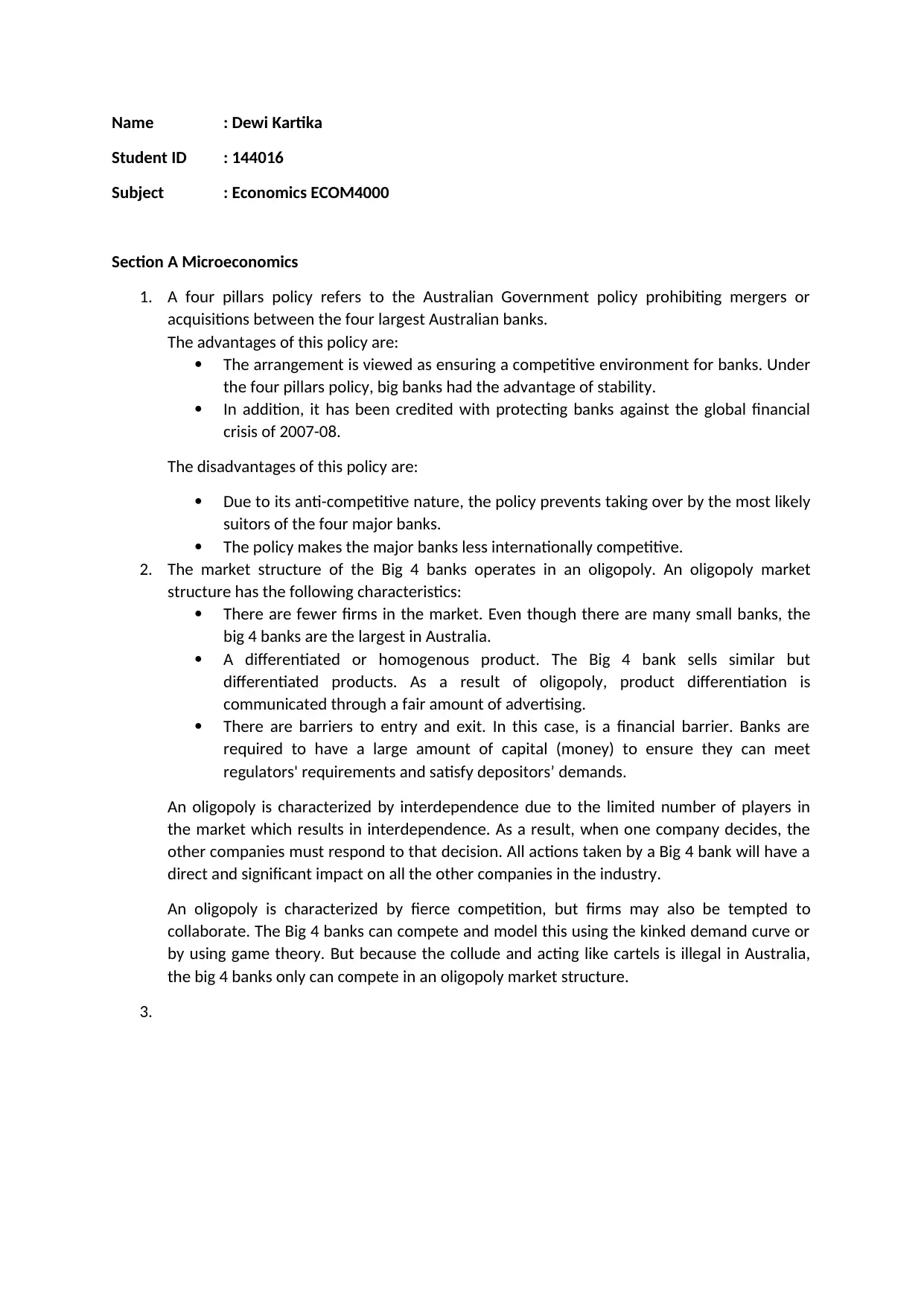
Name : Dewi Kartika
Student ID : 144016
Subject : Economics ECOM4000
Section A Microeconomics
1. A four pillars policy refers to the Australian Government policy prohibiting mergers or
acquisitions between the four largest Australian banks.
The advantages of this policy are:
The arrangement is viewed as ensuring a competitive environment for banks. Under
the four pillars policy, big banks had the advantage of stability.
In addition, it has been credited with protecting banks against the global financial
crisis of 2007-08.
The disadvantages of this policy are:
Due to its anti-competitive nature, the policy prevents taking over by the most likely
suitors of the four major banks.
The policy makes the major banks less internationally competitive.
2. The market structure of the Big 4 banks operates in an oligopoly. An oligopoly market
structure has the following characteristics:
There are fewer firms in the market. Even though there are many small banks, the
big 4 banks are the largest in Australia.
A differentiated or homogenous product. The Big 4 bank sells similar but
differentiated products. As a result of oligopoly, product differentiation is
communicated through a fair amount of advertising.
There are barriers to entry and exit. In this case, is a financial barrier. Banks are
required to have a large amount of capital (money) to ensure they can meet
regulators' requirements and satisfy depositors’ demands.
An oligopoly is characterized by interdependence due to the limited number of players in
the market which results in interdependence. As a result, when one company decides, the
other companies must respond to that decision. All actions taken by a Big 4 bank will have a
direct and significant impact on all the other companies in the industry.
An oligopoly is characterized by fierce competition, but firms may also be tempted to
collaborate. The Big 4 banks can compete and model this using the kinked demand curve or
by using game theory. But because the collude and acting like cartels is illegal in Australia,
the big 4 banks only can compete in an oligopoly market structure.
3.
Student ID : 144016
Subject : Economics ECOM4000
Section A Microeconomics
1. A four pillars policy refers to the Australian Government policy prohibiting mergers or
acquisitions between the four largest Australian banks.
The advantages of this policy are:
The arrangement is viewed as ensuring a competitive environment for banks. Under
the four pillars policy, big banks had the advantage of stability.
In addition, it has been credited with protecting banks against the global financial
crisis of 2007-08.
The disadvantages of this policy are:
Due to its anti-competitive nature, the policy prevents taking over by the most likely
suitors of the four major banks.
The policy makes the major banks less internationally competitive.
2. The market structure of the Big 4 banks operates in an oligopoly. An oligopoly market
structure has the following characteristics:
There are fewer firms in the market. Even though there are many small banks, the
big 4 banks are the largest in Australia.
A differentiated or homogenous product. The Big 4 bank sells similar but
differentiated products. As a result of oligopoly, product differentiation is
communicated through a fair amount of advertising.
There are barriers to entry and exit. In this case, is a financial barrier. Banks are
required to have a large amount of capital (money) to ensure they can meet
regulators' requirements and satisfy depositors’ demands.
An oligopoly is characterized by interdependence due to the limited number of players in
the market which results in interdependence. As a result, when one company decides, the
other companies must respond to that decision. All actions taken by a Big 4 bank will have a
direct and significant impact on all the other companies in the industry.
An oligopoly is characterized by fierce competition, but firms may also be tempted to
collaborate. The Big 4 banks can compete and model this using the kinked demand curve or
by using game theory. But because the collude and acting like cartels is illegal in Australia,
the big 4 banks only can compete in an oligopoly market structure.
3.
Paraphrase This Document
Need a fresh take? Get an instant paraphrase of this document with our AI Paraphraser
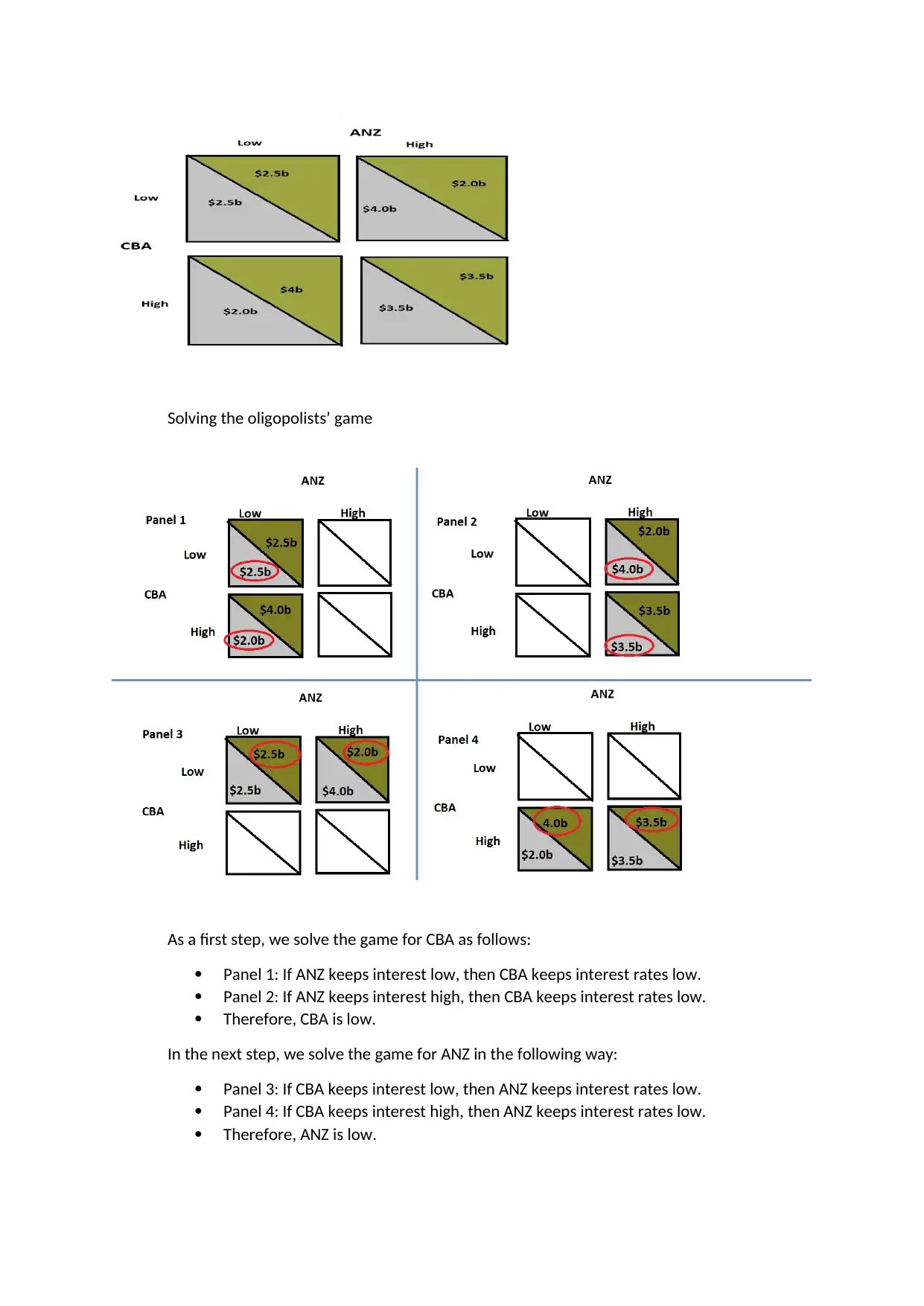
Solving the oligopolists’ game
As a first step, we solve the game for CBA as follows:
Panel 1: If ANZ keeps interest low, then CBA keeps interest rates low.
Panel 2: If ANZ keeps interest high, then CBA keeps interest rates low.
Therefore, CBA is low.
In the next step, we solve the game for ANZ in the following way:
Panel 3: If CBA keeps interest low, then ANZ keeps interest rates low.
Panel 4: If CBA keeps interest high, then ANZ keeps interest rates low.
Therefore, ANZ is low.
As a first step, we solve the game for CBA as follows:
Panel 1: If ANZ keeps interest low, then CBA keeps interest rates low.
Panel 2: If ANZ keeps interest high, then CBA keeps interest rates low.
Therefore, CBA is low.
In the next step, we solve the game for ANZ in the following way:
Panel 3: If CBA keeps interest low, then ANZ keeps interest rates low.
Panel 4: If CBA keeps interest high, then ANZ keeps interest rates low.
Therefore, ANZ is low.
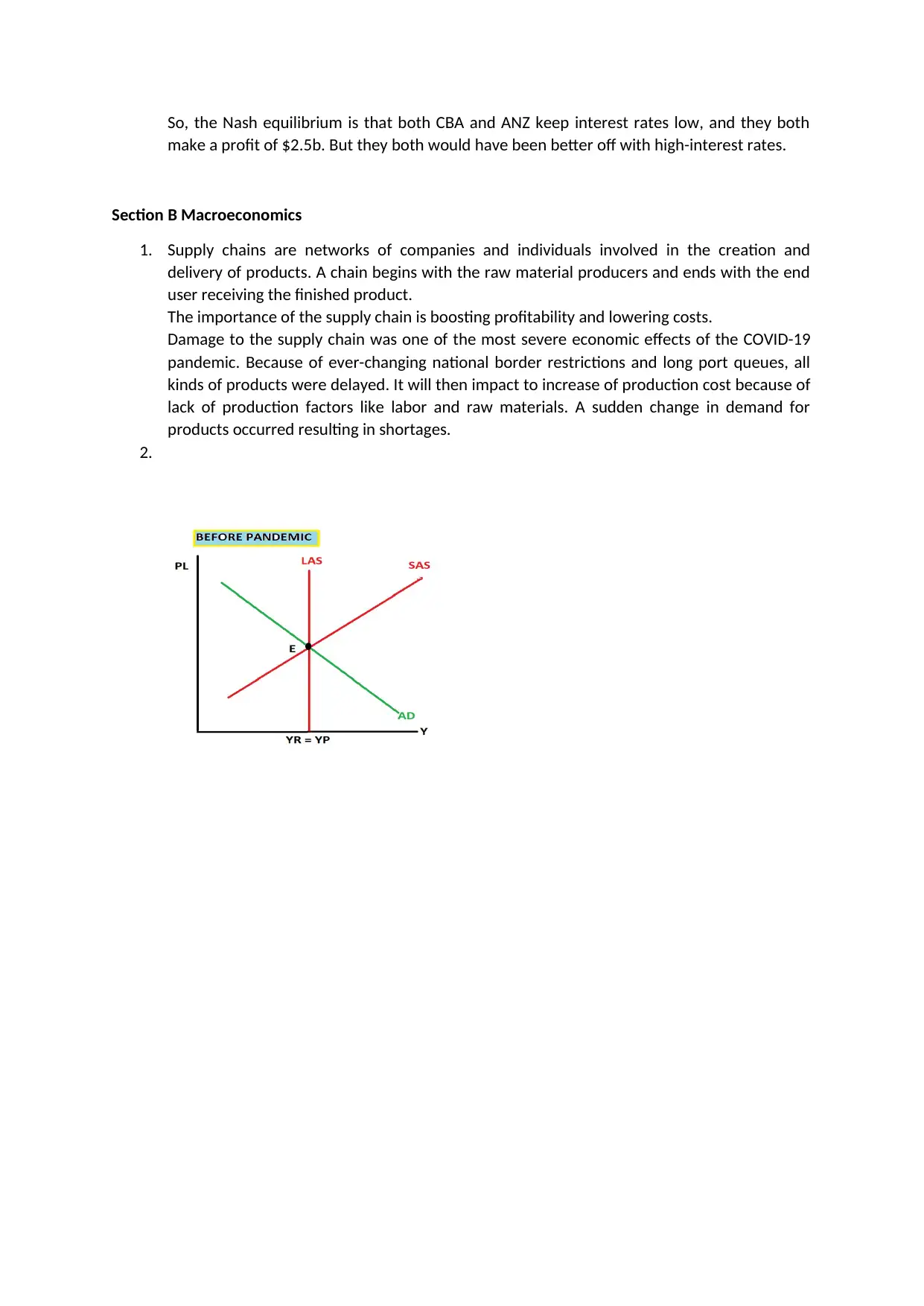
So, the Nash equilibrium is that both CBA and ANZ keep interest rates low, and they both
make a profit of $2.5b. But they both would have been better off with high-interest rates.
Section B Macroeconomics
1. Supply chains are networks of companies and individuals involved in the creation and
delivery of products. A chain begins with the raw material producers and ends with the end
user receiving the finished product.
The importance of the supply chain is boosting profitability and lowering costs.
Damage to the supply chain was one of the most severe economic effects of the COVID-19
pandemic. Because of ever-changing national border restrictions and long port queues, all
kinds of products were delayed. It will then impact to increase of production cost because of
lack of production factors like labor and raw materials. A sudden change in demand for
products occurred resulting in shortages.
2.
make a profit of $2.5b. But they both would have been better off with high-interest rates.
Section B Macroeconomics
1. Supply chains are networks of companies and individuals involved in the creation and
delivery of products. A chain begins with the raw material producers and ends with the end
user receiving the finished product.
The importance of the supply chain is boosting profitability and lowering costs.
Damage to the supply chain was one of the most severe economic effects of the COVID-19
pandemic. Because of ever-changing national border restrictions and long port queues, all
kinds of products were delayed. It will then impact to increase of production cost because of
lack of production factors like labor and raw materials. A sudden change in demand for
products occurred resulting in shortages.
2.
⊘ This is a preview!⊘
Do you want full access?
Subscribe today to unlock all pages.

Trusted by 1+ million students worldwide
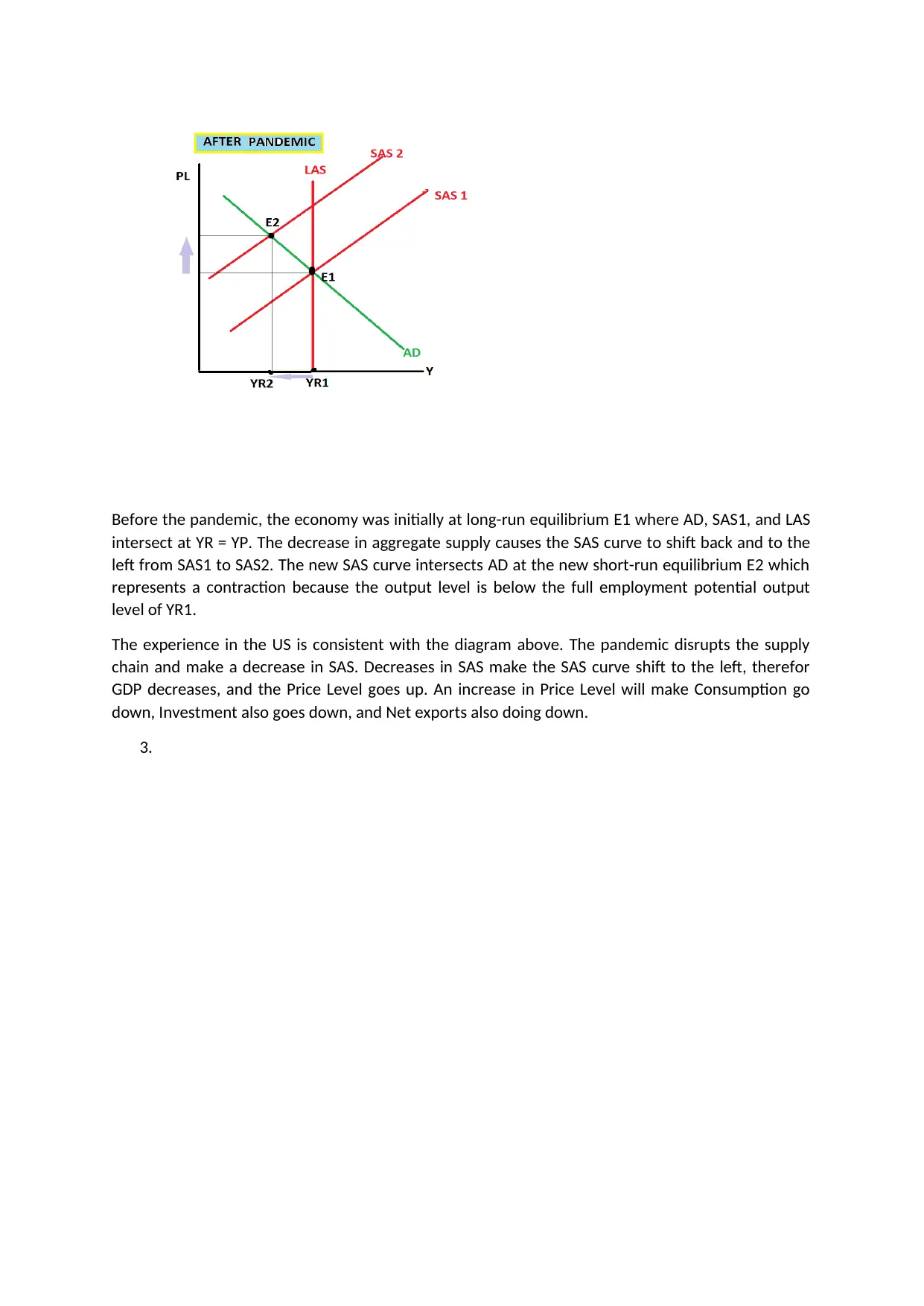
Before the pandemic, the economy was initially at long-run equilibrium E1 where AD, SAS1, and LAS
intersect at YR = YP. The decrease in aggregate supply causes the SAS curve to shift back and to the
left from SAS1 to SAS2. The new SAS curve intersects AD at the new short-run equilibrium E2 which
represents a contraction because the output level is below the full employment potential output
level of YR1.
The experience in the US is consistent with the diagram above. The pandemic disrupts the supply
chain and make a decrease in SAS. Decreases in SAS make the SAS curve shift to the left, therefor
GDP decreases, and the Price Level goes up. An increase in Price Level will make Consumption go
down, Investment also goes down, and Net exports also doing down.
3.
intersect at YR = YP. The decrease in aggregate supply causes the SAS curve to shift back and to the
left from SAS1 to SAS2. The new SAS curve intersects AD at the new short-run equilibrium E2 which
represents a contraction because the output level is below the full employment potential output
level of YR1.
The experience in the US is consistent with the diagram above. The pandemic disrupts the supply
chain and make a decrease in SAS. Decreases in SAS make the SAS curve shift to the left, therefor
GDP decreases, and the Price Level goes up. An increase in Price Level will make Consumption go
down, Investment also goes down, and Net exports also doing down.
3.
Paraphrase This Document
Need a fresh take? Get an instant paraphrase of this document with our AI Paraphraser
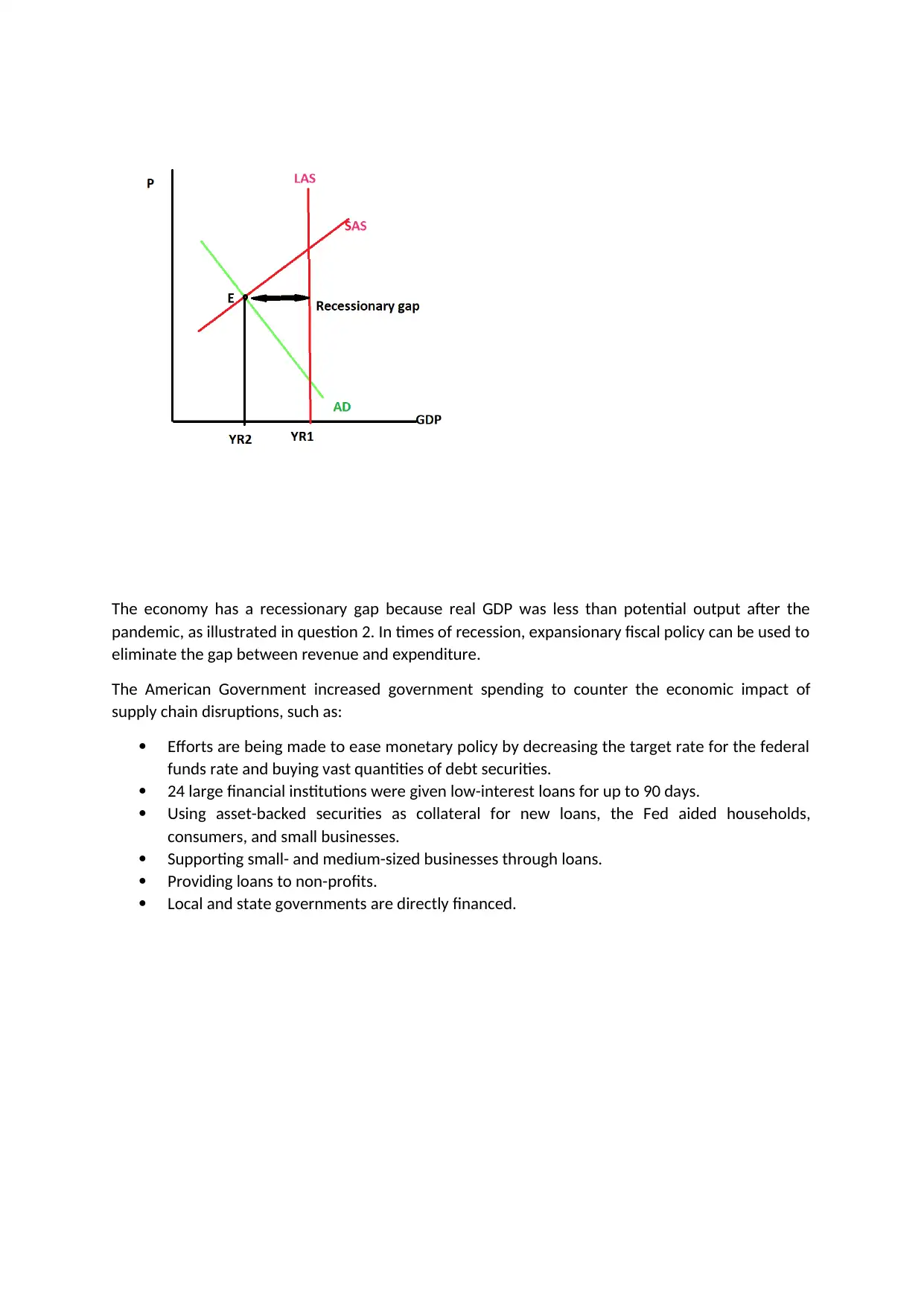
The economy has a recessionary gap because real GDP was less than potential output after the
pandemic, as illustrated in question 2. In times of recession, expansionary fiscal policy can be used to
eliminate the gap between revenue and expenditure.
The American Government increased government spending to counter the economic impact of
supply chain disruptions, such as:
Efforts are being made to ease monetary policy by decreasing the target rate for the federal
funds rate and buying vast quantities of debt securities.
24 large financial institutions were given low-interest loans for up to 90 days.
Using asset-backed securities as collateral for new loans, the Fed aided households,
consumers, and small businesses.
Supporting small- and medium-sized businesses through loans.
Providing loans to non-profits.
Local and state governments are directly financed.
pandemic, as illustrated in question 2. In times of recession, expansionary fiscal policy can be used to
eliminate the gap between revenue and expenditure.
The American Government increased government spending to counter the economic impact of
supply chain disruptions, such as:
Efforts are being made to ease monetary policy by decreasing the target rate for the federal
funds rate and buying vast quantities of debt securities.
24 large financial institutions were given low-interest loans for up to 90 days.
Using asset-backed securities as collateral for new loans, the Fed aided households,
consumers, and small businesses.
Supporting small- and medium-sized businesses through loans.
Providing loans to non-profits.
Local and state governments are directly financed.
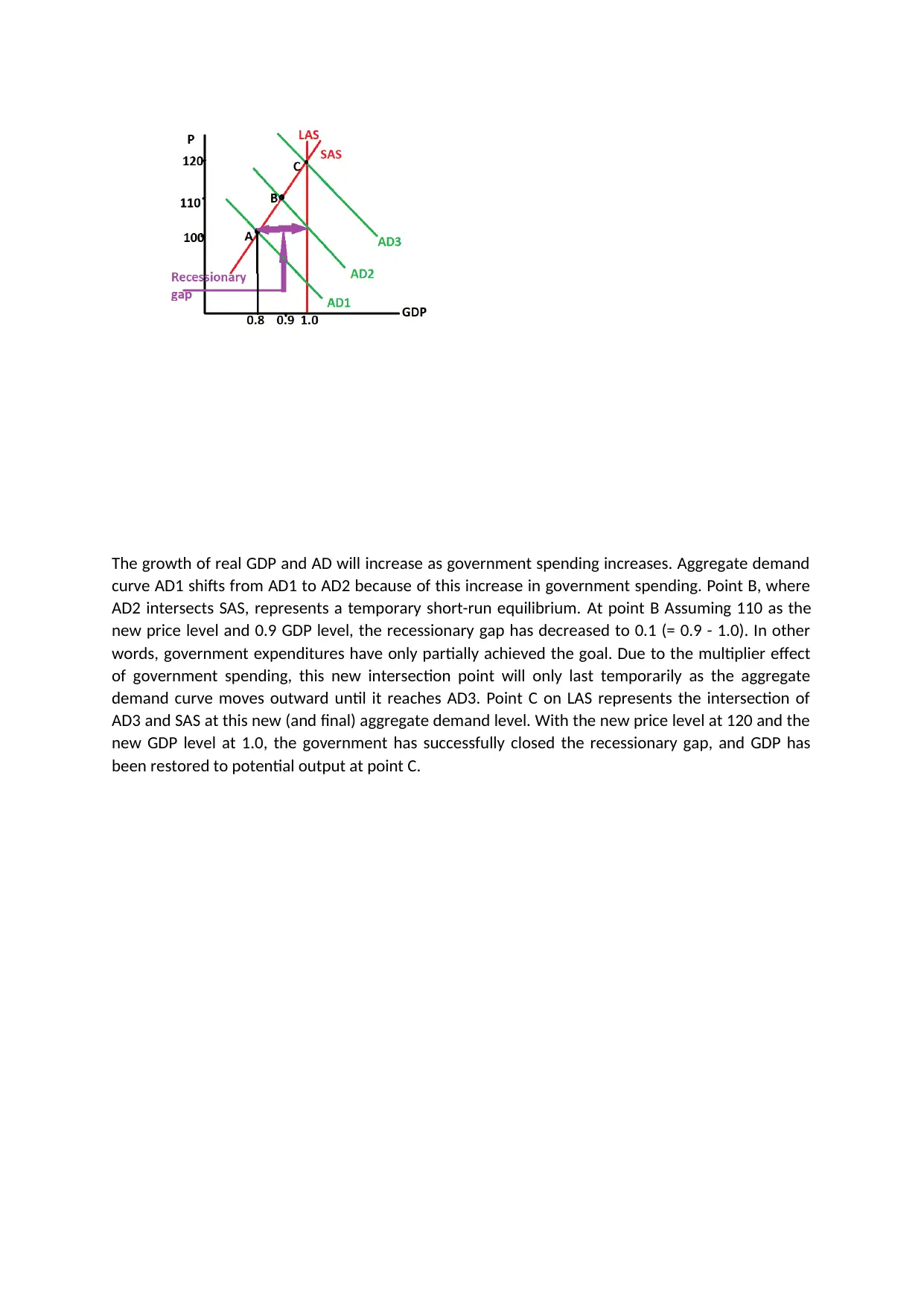
The growth of real GDP and AD will increase as government spending increases. Aggregate demand
curve AD1 shifts from AD1 to AD2 because of this increase in government spending. Point B, where
AD2 intersects SAS, represents a temporary short-run equilibrium. At point B Assuming 110 as the
new price level and 0.9 GDP level, the recessionary gap has decreased to 0.1 (= 0.9 - 1.0). In other
words, government expenditures have only partially achieved the goal. Due to the multiplier effect
of government spending, this new intersection point will only last temporarily as the aggregate
demand curve moves outward until it reaches AD3. Point C on LAS represents the intersection of
AD3 and SAS at this new (and final) aggregate demand level. With the new price level at 120 and the
new GDP level at 1.0, the government has successfully closed the recessionary gap, and GDP has
been restored to potential output at point C.
curve AD1 shifts from AD1 to AD2 because of this increase in government spending. Point B, where
AD2 intersects SAS, represents a temporary short-run equilibrium. At point B Assuming 110 as the
new price level and 0.9 GDP level, the recessionary gap has decreased to 0.1 (= 0.9 - 1.0). In other
words, government expenditures have only partially achieved the goal. Due to the multiplier effect
of government spending, this new intersection point will only last temporarily as the aggregate
demand curve moves outward until it reaches AD3. Point C on LAS represents the intersection of
AD3 and SAS at this new (and final) aggregate demand level. With the new price level at 120 and the
new GDP level at 1.0, the government has successfully closed the recessionary gap, and GDP has
been restored to potential output at point C.
⊘ This is a preview!⊘
Do you want full access?
Subscribe today to unlock all pages.

Trusted by 1+ million students worldwide
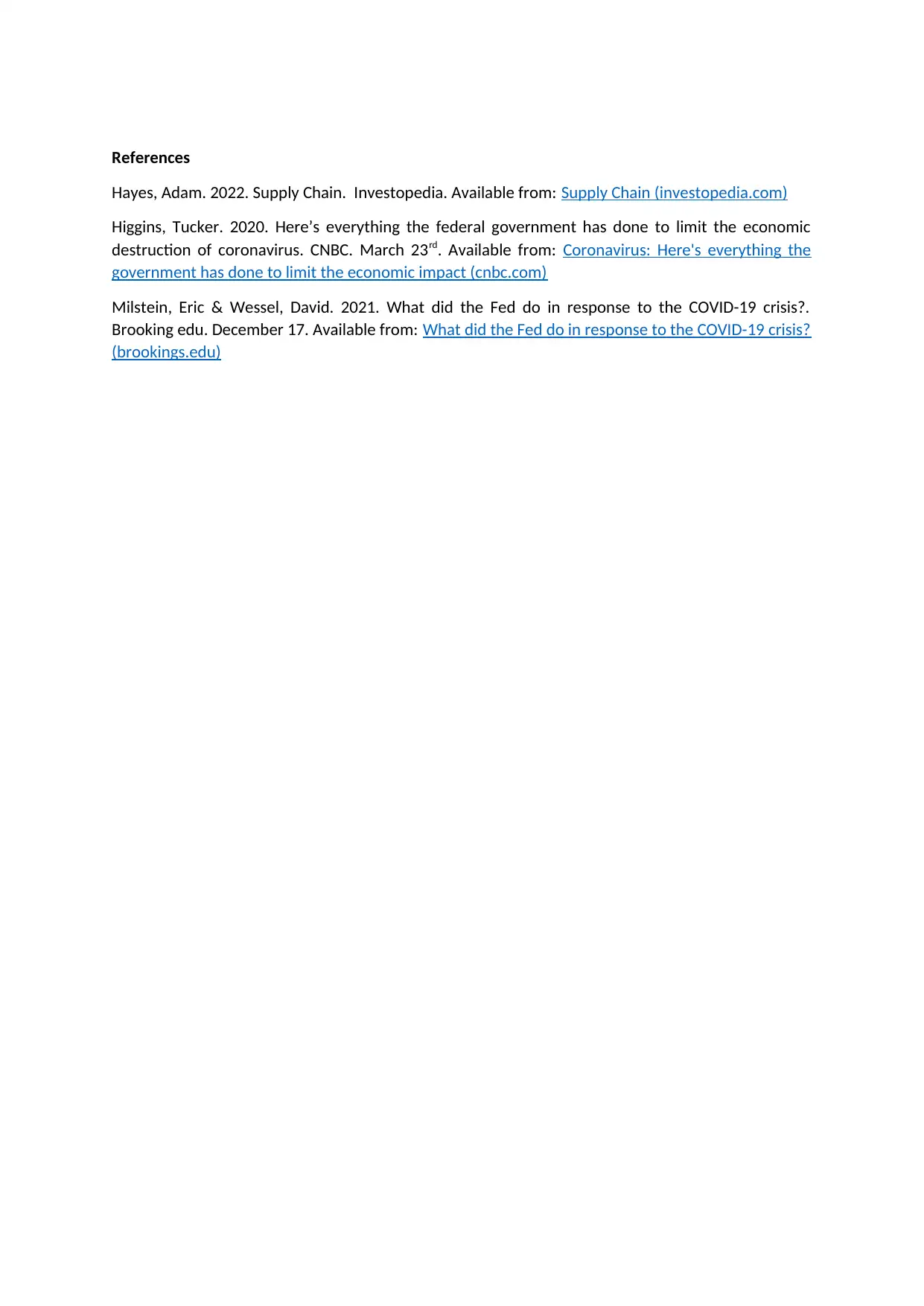
References
Hayes, Adam. 2022. Supply Chain. Investopedia. Available from: Supply Chain (investopedia.com)
Higgins, Tucker. 2020. Here’s everything the federal government has done to limit the economic
destruction of coronavirus. CNBC. March 23rd. Available from: Coronavirus: Here's everything the
government has done to limit the economic impact (cnbc.com)
Milstein, Eric & Wessel, David. 2021. What did the Fed do in response to the COVID-19 crisis?.
Brooking edu. December 17. Available from: What did the Fed do in response to the COVID-19 crisis?
(brookings.edu)
Hayes, Adam. 2022. Supply Chain. Investopedia. Available from: Supply Chain (investopedia.com)
Higgins, Tucker. 2020. Here’s everything the federal government has done to limit the economic
destruction of coronavirus. CNBC. March 23rd. Available from: Coronavirus: Here's everything the
government has done to limit the economic impact (cnbc.com)
Milstein, Eric & Wessel, David. 2021. What did the Fed do in response to the COVID-19 crisis?.
Brooking edu. December 17. Available from: What did the Fed do in response to the COVID-19 crisis?
(brookings.edu)
Paraphrase This Document
Need a fresh take? Get an instant paraphrase of this document with our AI Paraphraser
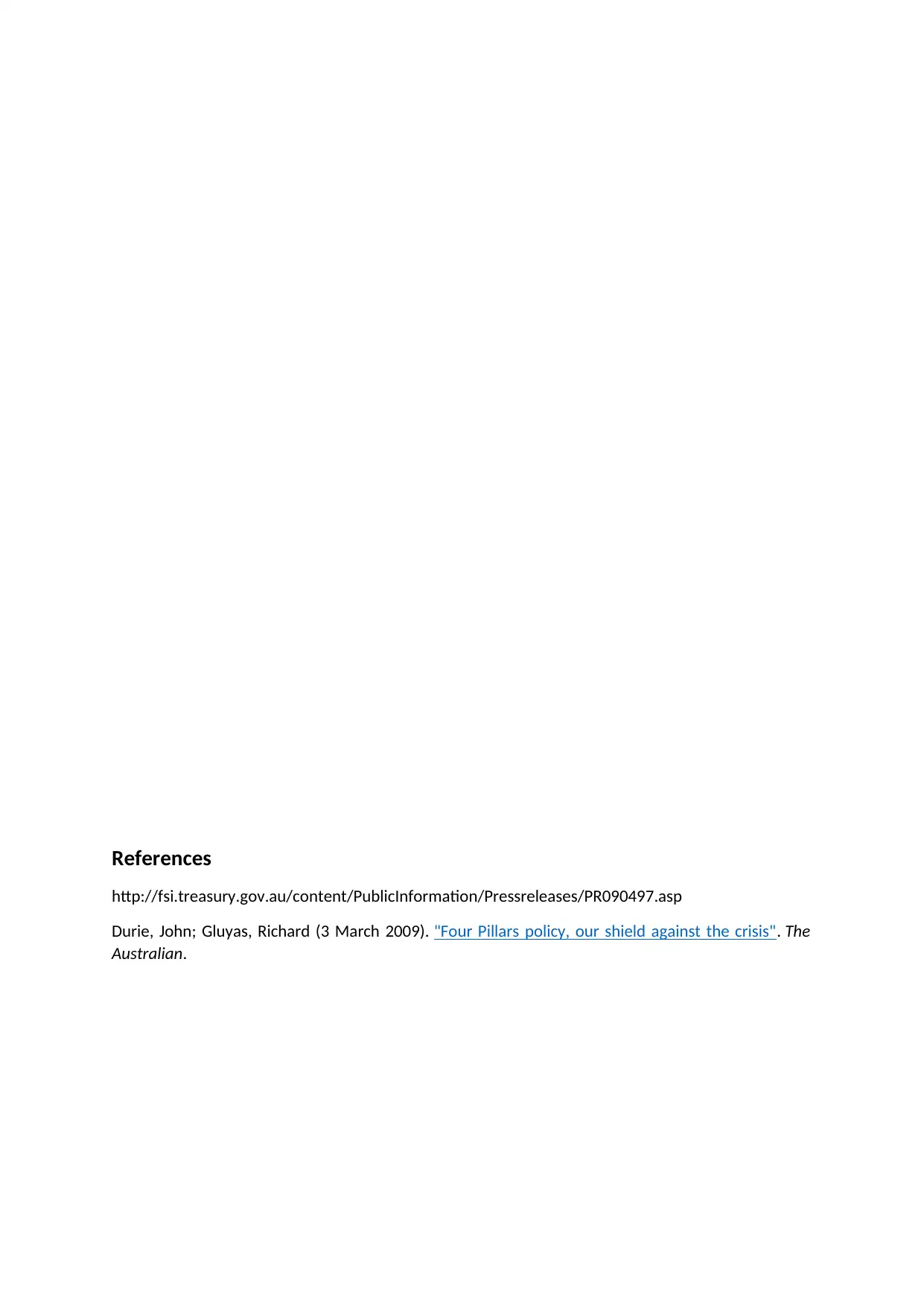
References
http://fsi.treasury.gov.au/content/PublicInformation/Pressreleases/PR090497.asp
Durie, John; Gluyas, Richard (3 March 2009). "Four Pillars policy, our shield against the crisis". The
Australian.
http://fsi.treasury.gov.au/content/PublicInformation/Pressreleases/PR090497.asp
Durie, John; Gluyas, Richard (3 March 2009). "Four Pillars policy, our shield against the crisis". The
Australian.

⊘ This is a preview!⊘
Do you want full access?
Subscribe today to unlock all pages.

Trusted by 1+ million students worldwide
1 out of 9
Related Documents
Your All-in-One AI-Powered Toolkit for Academic Success.
+13062052269
info@desklib.com
Available 24*7 on WhatsApp / Email
![[object Object]](/_next/static/media/star-bottom.7253800d.svg)
Unlock your academic potential
Copyright © 2020–2025 A2Z Services. All Rights Reserved. Developed and managed by ZUCOL.





